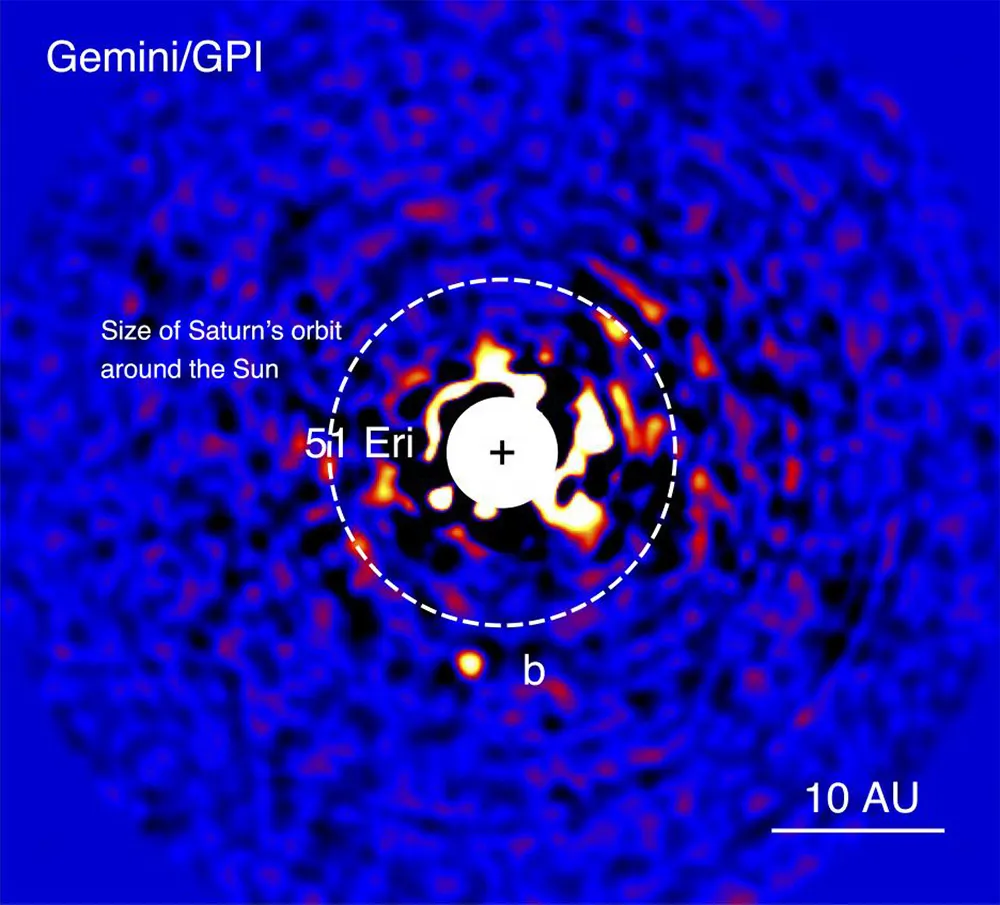The James Webb Space Telescope has directly imaged a planet orbiting another star just 12 lightyears from Earth.
The exoplanet, known as Epsilon Indi Ab, is one of the coldest exoplanets ever directly observed, at a freezing 2°C (35°F).
It's several times the mass of Jupiter – a 'super Jupiter' – and orbits star Epsilon Indi A (Eps Ind A), which is about the age of our Sun but slightly cooler.
The team of scientists behind the study say this system is much more like our own Solar System than others, making this a great opportunity to study a Solar System analogue.

Studying Epsilon Indi Ab
The astronomers observed Epsilon Indi Ab using an instrument known as a coronagraph on Webb’s MIRI (Mid-Infrared Instrument).
A coronagraph is often used in solar science, and the most well-known is probably the coronagraph on NASA's SOHO spacecraft.
This instrument is used to block out the bright centre of the Sun, in order to observe other parts of the Sun that would normally be washed out, like solar flares and solar prominences.
The same is true for this exoplanet image: the coronagraph blocks out light from the host star, in order to reveal the planet in orbit around it.
This is like holding your hand up to the Sun on a sunny day, so you can better see what's in front of you.

The direct observation of Epsilon Indi Ab is something of an achievement in itself: only a few tens of exoplanets have been directly imaged.
"Our prior observations of this system have been more indirect measurements of the star, which actually allowed us to see ahead of time that there was likely a giant planet in this system tugging on the star," says team member Caroline Morley of the University of Texas at Austin.
"That's why our team chose this system to observe first with Webb."
"This discovery is exciting because the planet is quite similar to Jupiter — it is a little warmer and is more massive, but is more similar to Jupiter than any other planet that has been imaged so far," says lead author Elisabeth Matthews of the Max Planck Institute for Astronomy in Germany.

Is Epsilon Indy A like our Solar System?
Exoplanets that have been directly imaged in the past tend to be young, hot and radiating energy, which makes them easier to see and image.
As you might expect, cooler, older exoplanets are fainter and harder to image.
"Cold planets are very faint, and most of their emission is in the mid-infrared," says Matthews.
"Webb is ideally suited to conduct mid-infrared imaging, which is extremely hard to do from the ground.
"We also needed good spatial resolution to separate the planet and the star in our images, and the large Webb mirror is extremely helpful in this aspect."
Epsilon Indi Ab is one of the coldest exoplanets directly detected and is colder than any other imaged planet beyond our Solar System.
The exoplanet is by no means as cold as the coldest place on Earth, but it's still chilly: just 100°C (180°F) warmer than the gas giants in our Solar System.
"Astronomers have been imagining planets in this system for decades; fictional planets orbiting Epsilon Indi have been the sites of Star Trek episodes, novels, and video games like Halo," says Morley.
"It's exciting to actually see a planet there ourselves, and begin to measure its properties."

More to learn
Epsilon Indi Ab is the twelfth closest exoplanet to Earth known to date, and is the closest planet discovered that's more massive than Jupiter.
The system intrigued the research team because the host star, Eps Ind A, showed signs of hosting a planet in orbit via the radial velocity method of detection.
This technique measures how a star wobbles as a result of the gravitational tug of a planet in orbit.
"While we expected to image a planet in this system, because there were radial velocity indications of its presence, the planet we found isn't what we had predicted," says Matthews.
"It’s about twice as massive, a little farther from its star, and has a different orbit than we expected. The cause of this discrepancy remains an open question.
"The atmosphere of the planet also appears to be a little different than the model predictions. So far we only have a few photometric measurements of the atmosphere, meaning that it is hard to draw conclusions, but the planet is fainter than expected at shorter wavelengths."
According to the team, this could mean there is methane, carbon monoxide and carbon dioxide in the atmosphere of Epsilon Indi Ab that's absorbing shorter wavelengths of light.
It also means Epsilon Indi Ab could be very cloudy.
Future studies by the team could include photometric and spectroscopic observations of the exoplanet, as well as detections of other similar planets to learn more about this type of planet and how they form.
These results were taken with Webb’s Cycle 1 General Observer program 2243 and have been published in the journal Nature.

